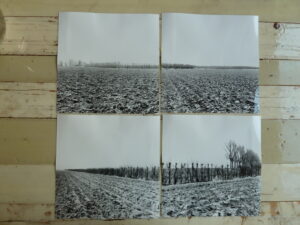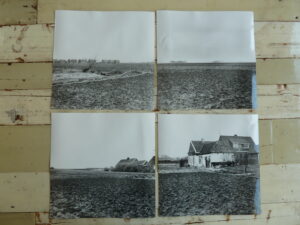‘Live in your head’ – Reinjan Mulder and his 1974 photo-experiment ‘Objective Netherlands’
By Ludo van Halem
Curator 20th Century Art at the Rijksmuseum Amsterdam
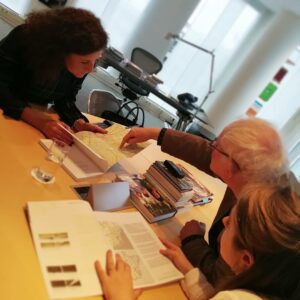
In 2019 Reinjan Mulder and Cleo Wächter presented their photo-experiment ‘Objective Netherlands’ at the Dutch Department of Culture. Minister Ingrid van Engelshoven (left) with Reinjan Mulder (m) and Cleo Wächter (r)
On 31 January 1974, in the Limburg village of Roosteren 24, Reinjan Mulder took a picture of a blank wall. We mostly see grayish plaster, which seems to have been ap-plied somewhat irregularly and has weathered over time. To the right is a buttress, and to the left, in the foreground, a few bare branches of a bush have come into view. At upper right a narrow strip of sky stands out, a white triangle that contrasts sharply with the dark-gray plaster. It would be difficult to call the photo stimulating or exciting. Boring is probably a better word.
The blank wall is the subject of one of the 208 photographs that together comprise the project Objective View of the Netherlands: the ‘photo experiment’ with which Mulder aimed to visualize the landscape of the Netherlands with-out letting subjective aesthetic preferences or picturesque visual conventions play a role; in his view, these were often too emphatically present in the representation of the land-scape. The project was submitted to the Amsterdam municipal government as a proposal for an experimental photo commission in 1971, but it was turned down. A new application to the then-Ministry of Culture, Recreation and Social Work for an artistic experiment subsidy was more successful and was approved two years later.
With the photo experiment he intended to ‘provide a random view of the Netherlands over the course of a year’, as he formulated it at the time: ‘Random, that is to say not deformed by the personal preferences of the photographer, no selection of the material based on importance or beauty. (…) The method followed will be a reasonable guarantee that the average landscape, the average weather conditions and populations are recorded.’
This method can be briefly summarized: over the map of the Netherlands, he laid a uniform grid that produced 52 intersections, which would be reachable by public transport [fig. 2]. Armed with an analogue Rolleiflex twin-lens camera, loaded with Kodak Tri-X black-and-white negative film, Mulder spent the first half of 1974 travelling across the Netherlands, ending up countless times in an open field and a few times in a boat on open water or in a wood. There he would set up his camera and then take an eye-level photograph in each of the four cardinal directions. Once, the grid dictated a shot in a living room, in the village of Velp 45 in Gelderland. And in a back garden in Roosteren, where he took four photos at about 1:01 p.m. on 31 January, a blank wall blocked the view to the south.
In the portrait of the landscape of the Netherlands created by this system, this impeded view is the exception that confirms the consistency of the method. The boring quality of the image, on the other hand, is anything but exceptional. The Netherlands that Reinjan Mulder photographed in 1974 is strikingly empty and gray, with bare trees and bushes, and gray, cloudy skies that cast a shadowless light over the landscape. It is as silent and cold there as a frigid day in March, and only rarely does one of the 13.5 million inhabitants the Netherlands had at the time come into view. How ‘objective’ and ‘random’ is this Netherlands, actually? Did the 52 grid points on the map really form a representative sample of the Dutch landscape? For they provide a surprisingly uniform image in which the urban landscape is noticeable by its absence, as though Mulder had deliberately avoided it. Motorways, industrial estates and dock-lands are similarly absent or, at most, glimpsed far away on the horizon. And where are the pastoral panora mas of the great rivers, the Delta Works, the bocages of Twente or the rolling hills of Southern Limburg? Were these too picturesque, was the net Mulder cast too coarse-meshed for this, or does his ‘objectivity’ conceal an aesthetic predilection after all?
In 1971, when he submitted his photo project to the Amster-dam municipal government, Mulder was a 22-year-old philosophy and law student. His application was turned down because he was not a professional photographer. But in addition to a student, he was also a talented young poet who had debuted in the respected literary periodical De Gids. In his youth in Geldermalsen, in the Betuwe, he had met various artists, including Marinus van den Boezem, through his father, the painter Piet Mulder. When he moved to Amsterdam in 1966 he began to draw, write and take photographs.
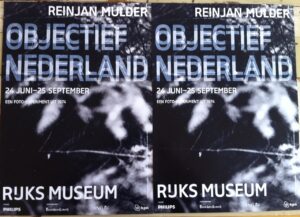
Posters of the 2016 Rijksmuseum Exhibition of Reinjan Mulders ‘Objective Netherlands’. Design: Irma Boom.
.
In this instance, this early biography of an apparently happy adolescence full of art and literature is significant, because it took place at a time when new tendencies and movements in the arts followed one another in rapid succession, often overlapping, and the relationship of art to reality in particular was constantly redefined. For example, when Mulder, halfway through this decade of artistic upheavals, arrived in Amsterdam at the age of 17, De Nieuwe Stijl (The New Style) had just come out, a solid overview in two volumes of the ‘new poetry’ and the Zero art that had manifested itself with aplomb in the first half of the 1960s.
De Nieuwe Stijl expressed ‘a new idea of reality, in which the individualism of the artist is reduced to its minimum’, as visual artist Jan Schoonhoven formulated it. ‘The zero-artist only chooses, isolates parts of reality (…) and is showing them in the most indifferent way as possible. To avoid disturbing with personal feelings is fundamental to zero. Accepting things just as they are and not changing them for artificial reasons (…) to show reality in a stronger way.’ How effective this ‘isolating’ and ‘intensifying’ could be was demonstrated by the painter-poet Armando in such works as his ‘Agrarian Cycle’, which consisted of phrases taken from an advertising brochure for farm equipment:
with steel teeth.
the roots of the mown crops are not damaged.
the weed is killed in the bud.
with steel teeth.
the ‘clean land’ effect must be astonishing.
Whether the young poet Mulder felt an affinity with this is not all that important; what is evident is that the mentality and method of Zero and the ‘new poetry’ defined his outlook as an experimental photographer to a significant degree; he became, in Armando’s words, ‘an artist who is no longer an artist: a cool, pragmatic eye.’ The method he followed in portraying the landscape of the Netherlands was that of an ‘objective’ choice in which 52 ‘parts of reality’ were ‘isolated’. The repetition of the photos in the four directions of the compass underscored this objectivity. In this Mulder was following another aspect of Schoonhoven’s aesthetic programme: ‘Succession of one motive (…), one piece of isolated reality by repetition contains except rhythm also time and at the same time because of the repetition a suggestion of lack of time. This antithesis (…), in spite of the monotony, (entails) the greatest hidden tension as possible.’
With this conceptual leap, ‘boring’ was transformed into its opposite in a monumental way, as demonstrated not only by Schoonhoven with an endless stream of reliefs in which every conceivable variation of the white square was attempted, but also by Andy Warhol, for example, who in 1964 pointed his camera at the Empire State Building and let it run for six and a half hours. The passage of time was made visible by the darkness falling and the electric lights coming on.
The man-made landscape of the Netherlands, too, displayed an empty and boring appearance that was seen as an aesthetic quality in the 1960s. This is evident, for example, from the Super-8 films shot by German artist Charlotte Posenenske under the motto ‘Monotonie ist schön’ (‘Monotony is beautiful’) on a road trip across the Nether-lands in 1968: ‘The trips to Zeeland and Flevoland were unforgettable. I like the artificial, the produced and maintained qualities there. Our films are so terribly amateurish and boring. For example: Beginning of the Dam – Dam – End of the Dam. Or forty-seven identical trees’, she wrote to the Art & Project gallery in Amsterdam.
When the exhibition ‘Op losse schroeven’ (‘Square Pegs in Round Holes’) opened at the Stedelijk Museum in Amsterdam in 1969, an artwork by one of Mulder’s father’s acquaintances from the Betuwe graced the cover of the catalogue: a weather map by Marinus Boezem (by then the prefixes had been jettisoned). Along with Jan Dibbets and Ger van Elk, Boezem was the driving force behind this exhibition, which provided, for the first time in the Netherlands, an overview of recent international developments in conceptual art, for which many other names were coined at the time, like micro-emotive art or process art. A large number of artists sought a connection with the world outside the museum and stepped beyond the traditional domain of art by explicitly incorporating natural processes or natural materials in their work. In land art, the earth became the canvass on which they worked; the use of perishable, natural materials earned the moniker arte povera.
‘Op losse schroeven’ was followed two years later by the exhibition ‘Sonsbeek buiten de perken’ (‘Sonsbeek out-side the bounds’). The traditional, recurring sculpture exhibition in the Sonsbeek park in Arnhem evolved into an event in which Dutch and foreign artists were able to create art-works, based on pre-submitted plans — this had also been the case for ‘Op losse schroeven’ — throughout the Nether-lands, from Almelo to Wijk bij Duurstede. With a map on page 18 and an overview of the project proposals, the exhibition catalogue served as a guidebook.
So while ‘Sonsbeek buiten de perken’ must still have been going on and ‘Op losse schroeven’ still resonated in the collective art memory, Reinjan Mulder responded to a call by the Amsterdam culture department for proposals for a photo experiment. Under the title ‘Netherlands Random Photo Project’, he described, on two neatly typed pages, the premise, method, purpose and elaboration of his ambition ‘to offer contemporaries indispensable insight into reality, to clarify the concept of the contemporaneous and to provide study material for posterity’. And so he did, admittedly with a few hurdles, but in retrospect these do not matter very much.
What does matter is the result, which is of course anything but ‘objective’ and has been coloured by time. More than 40 years later, we see how Mulder’s gaze rep-resents the ‘now’ of 1974. He shaped Objective View of the Netherlands according to the latest aesthetics of the avant-garde, as they had gradually been delineated during that decade of artistic upheavals. The serial and systematic were part of this, but so were regulation or acceptance of chance, emptiness, boredom and monotony, working with proposals, with maps and travel, predilection for the countryside and nature, attention to the weather and elements like air and water, and certainly the predilection for grainy black-and-white photography as well, reflected in the dingy black-and-white reproductions in art publications of the period. Many of these elements are unmistakably present in Objective View of the Netherlands, with which Mulder, on his own, ventured outside the bounds of the picturesque visual conventions of landscape photography and painting.
Rephotography by Cleo Wächter
On 25 January 2017, in the Limburg village of Roosteren, Cleo Wächter took a photo of a blank wall [fig. 7]. We can see grayish plaster that, as a result of rain and weathering, shows a rich gradation of gray, brown and black tones, speck-led with round spots of lichen. To the right is a buttress along which a gray electric cable is affixed. A wheelbarrow with orange handles leans against the buttress. In the fore-ground, on a white table, a display has been made using a lantern, a drinking glass, two vases and a jug of coloured pottery, as well as a square flower pot bearing a framed text of religious nature, exhorting against fear and dated 14 May 1945. A string of Christmas lights is draped around it. It is an intriguing photo, full of enigmatic details.
The blank wall is the subject of one of the 208 photos that Wächter took in exactly the same locations as Reinjan Mulder 43 years previously, in a back garden in Roosteren with the lens pointed toward the south. The bare branches of a bush have made way for a kind of house altar (at least that is what it looks like), and what must then have been an open garden is now half covered. The radical image of then, empty and impregnable, has been transformed into an image filled with traces of human presence.

Launching the Book Objectief Nederland – Objective Netherlands: Cleo Wächter (l) Reinjan Mulder (m) and Rijksmuseum Curator Harm Stevens (r.)
Wächter’s 2017 rephotography of 1974’s Objective View of the Netherlands, at the invitation of Chief Government Advisor on the Built and Rural Environment Berno Strootman, not only shows the changes and continuity of the landscape of the Netherlands, which was of course the reason for the renewed project, but also clearly shows that we look with different eyes in 2017. When one lays the new photos next to Mulder’s and studies them attentively, one does indeed see buildings that were not there before, trees, bushes, lakes and ponds changing and sometimes even disappearing, and a new motorway appearing, its blue traffic signs standing out crisply against the landscape. But what emerges most strongly is the sense of proximity and immediacy in Wächter’s photos. For her, looking at the Dutch landscape of today also meant working with the resources of today. So she took photographs with a Canon EOS 5DS R digital single-lens reflex camera, the manufacturer of which has taken the lead in the resolution competition in digital image production with this type of camera. A resolution as high as possible, in this world, is tantamount to a greater experience of reality, and the sensor of Wächter’s digital Canon does produce, with over 50 million pixels, images of crystal clarity and profuse detail — in colour, of course — while Kodak’s black-and-white Tri-X negative film was prized, at the time, precisely for its coarse grain, which was sometimes emphasized even further through a forced developing process. The different image format and the different focal lengths of the lenses used also produce a completely different perspective. In Wächter’s photos this is much more definitely ‘foreshortened’, and it underscores a sense of proximity, whereas Mulder, with his empty, grainy vistas, created a meditative distance.
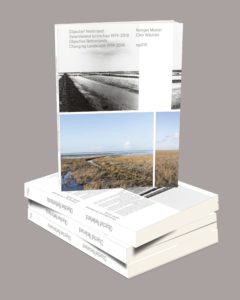 We owe the fact that we are able to make these illuminating comparisons today to the method Mulder developed in 1971: a set of rules that Wächter was able to follow relatively easily and that in the future can again be followed by any other photographer. Wächter’s reprise not only joins other rephotography projects recently carried out for scientific or artistic reasons, but also fits in with a trend of recreating performances (for example by Marina Abramović or Bruce Nauman) or the 2013 reconstruction of the conceptual art exhibition ‘When Attitudes Become Form’, originally held in parallel to ‘Op losse schroeven’ in Bern in 1969. It is no coincidence that such recreations have their origins in the time period in which Objective View of the Netherlands was created. An entire generation of artists was working with premises summed up by the American artist Sol LeWitt in his ‘Paragraphs on Conceptual Art’ (1967) and ‘Sentences on Conceptual Art’ (1969). With his wish to avoid ‘deformation by personal preferences’, Mulder was also following, almost literally, consciously or not, LeWitt’s formulation that the ‘idea becomes a machine that makes the art. (…) To work with a plan that is preset is one way of avoiding subjectivity. It also obviates the necessity of designing each work in turn. The plan would design the work. (…) This eliminates the arbitrary, the capricious, and the subjective as much as possible. This is the reason for using this method.’ The terminology has the appearance of rationality, but LeWitt, and others along with him, realized that the ‘rules’ of conceptual art also harboured a contradiction. This contradiction was in fact the irrationality of the artist searching for a truth behind reality. ‘Conceptual artists are mystics rather than rationalists. They leap to conclusions that logic cannot reach’, proclaimed the first of LeWitt’s ‘Sentences’. In 1967 Bruce Nauman had also created a neon sculpture with a similar text (‘The true artist helps the world by revealing mystic truths’) and the German artist Sigmar Polke thematized this irrationality in 1969 in an ironic way with a hard-edged black-and-white painting on which he painted in typewriter characters: Höhere Wesen befahlen: rechte obere Ecke schwarz malen! (‘Higher beings commanded: paint top-right corner black!’). Mulder too had hoped for such a mystical revelation, as he wrote when he turned his project over to the Rijksmuseum: ‘I wanted to show things, nature “as they were”, as they were without me. I wanted to see without looking. Break free of myself.’ He wanted to become the medium through which the true Netherlands would manifest itself.
We owe the fact that we are able to make these illuminating comparisons today to the method Mulder developed in 1971: a set of rules that Wächter was able to follow relatively easily and that in the future can again be followed by any other photographer. Wächter’s reprise not only joins other rephotography projects recently carried out for scientific or artistic reasons, but also fits in with a trend of recreating performances (for example by Marina Abramović or Bruce Nauman) or the 2013 reconstruction of the conceptual art exhibition ‘When Attitudes Become Form’, originally held in parallel to ‘Op losse schroeven’ in Bern in 1969. It is no coincidence that such recreations have their origins in the time period in which Objective View of the Netherlands was created. An entire generation of artists was working with premises summed up by the American artist Sol LeWitt in his ‘Paragraphs on Conceptual Art’ (1967) and ‘Sentences on Conceptual Art’ (1969). With his wish to avoid ‘deformation by personal preferences’, Mulder was also following, almost literally, consciously or not, LeWitt’s formulation that the ‘idea becomes a machine that makes the art. (…) To work with a plan that is preset is one way of avoiding subjectivity. It also obviates the necessity of designing each work in turn. The plan would design the work. (…) This eliminates the arbitrary, the capricious, and the subjective as much as possible. This is the reason for using this method.’ The terminology has the appearance of rationality, but LeWitt, and others along with him, realized that the ‘rules’ of conceptual art also harboured a contradiction. This contradiction was in fact the irrationality of the artist searching for a truth behind reality. ‘Conceptual artists are mystics rather than rationalists. They leap to conclusions that logic cannot reach’, proclaimed the first of LeWitt’s ‘Sentences’. In 1967 Bruce Nauman had also created a neon sculpture with a similar text (‘The true artist helps the world by revealing mystic truths’) and the German artist Sigmar Polke thematized this irrationality in 1969 in an ironic way with a hard-edged black-and-white painting on which he painted in typewriter characters: Höhere Wesen befahlen: rechte obere Ecke schwarz malen! (‘Higher beings commanded: paint top-right corner black!’). Mulder too had hoped for such a mystical revelation, as he wrote when he turned his project over to the Rijksmuseum: ‘I wanted to show things, nature “as they were”, as they were without me. I wanted to see without looking. Break free of myself.’ He wanted to become the medium through which the true Netherlands would manifest itself.
But this is only possible in imagination: ‘Live in your head’.
This text by Ludo van Halem (Rijksmuseum Amsterdam) was first published in the book ‘Objective Netherlands – Changing landscapes 1974-2018’ by Reinjan Mulder and Cleo Wächter. Nai010 Publishers, Rotterdam, 2018.
